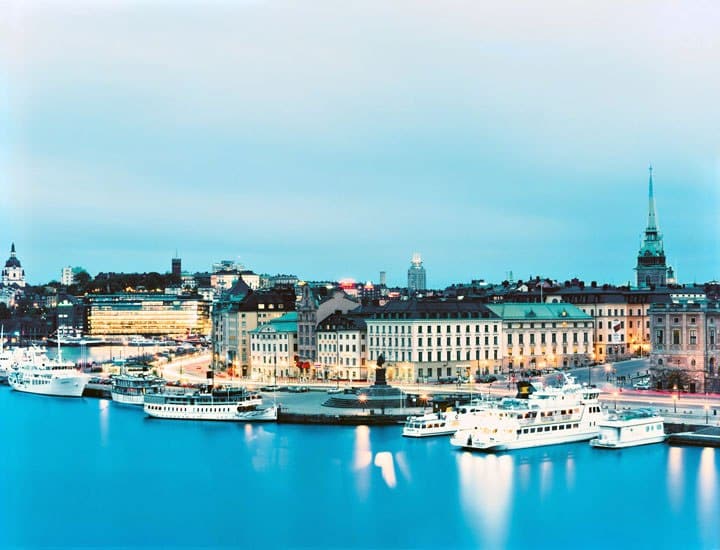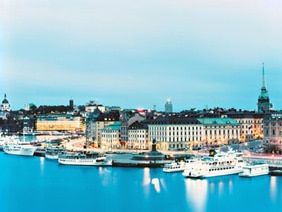The Swedish capital reveals itself to those who get an early start—or, better yet, never go to bed to begin with. Patrick Symmes stays up all night in a city that has morphed from cloistered enclave into a multi-ethnic mecca with a perfectionist streak a mile wide
The name of this blessing is jet lag. My memories of Madrid are the cold hours between 3 A.M. and the opening of a churro shop. Paris is always a pre-dawn blur. Copenhagen consists entirely of breakfasts. Now, here was Stockholm, from its medieval core to its twenty-first-century fringes, revealed empty and raw at four in the morning, at which time I was invariably either just getting up or just going to bed.
There I was, striding alone through the twisting cobblestone lanes of Gamla Stan, surveying the Renaissance cathedrals and the dark-windowed merchant houses, whose studied plainness—burnished to an alarming degree, every storefront neat and ambitious—speaks volumes about a people almost completely absent in those lonely hours before dawn.
Such an off-kilter approach reveals a place quickly. At 2 A.M., still early in my visit and tied by my circadian rhythms to work and family in America, I walked restlessly across this San Francisco–size city, where interior rivers pour out past an immense archipelago of 24,000 islands into the Baltic beyond. Stockholm itself is made up of fourteen islands, sewn together by fifty-seven bridges and backed by the steady sound of rushing tidal currents. Worried on first glance that the Swedish capital was too spick-and-span for my gritty taste, I soon stumbled upon police officers calmly facing down a hardened drug addict.

Water world: Stockholm’s Gamla Stan, or Old Town, occupies one of fourteen islands that constitute the capital.
The few others I saw in those wee hours were Chinese delivery drivers, kids struggling home from the late-night clubs of Norrmalm, and Surinamese cabbies surprisingly well versed in Rijk architecture and Baroque palaces. (However much the blond stereotype may endure, today’s Stockholm is a cosmopolitan, racially diverse city.) Each morning, at the end of my lonely patrols, I was tutored in the lip-twisting umlauts of the language by the very first employee to rattle his keys at some vaulted coffee bar in the Old Town. “Good morning—Coffee, thanks. Apple pie, thanks. Thanks.”
To see a city alone, empty, just a canvas—that’s the thing. I was looking for somebody during my visit, but until she showed up I had the place pretty much to myself. Jet lag. If you can keep your yawning mouth shut, it’s a good way to start a city.
Stockholm may be the most user-friendly metropolis on earth. Even the machines, from the whisper-quiet airport train to the luminous keyless-entry lock on a seventeenth-century town house, speak better English than you do. Too much perfection can make the city seem more bland than blond, but it exerts a subtle magic, a world-beating dream of sensible Scandinavian success.
Since I’ve never learned anything about a place by sleeping there, I forced myself slowly toward the Scandinavian clock—and the Swedish table. Food has opened a hundred doors for me, and the Swedes, like people everywhere, are what they eat.
“Sweden is in a wonderful transition,” the chef Marcus Samuelsson had told me in a briefing just before I left New York. Samuelsson helped establish the New Swedish cuisine that revived Stockholm’s dining scene in the 1990s, then came to America and conquered Manhattan with his Aquavit restaurant. “There is something contemporary and modernist occurring in Swedish culture in general, not just food,” Samuelsson had suggested. Comparing his native land with Spain, which is undergoing an across-the-board cultural renaissance, he noted that “Stockholm is very modern right now. Trendy, maybe.”
Design is old news, food has popped, and denim has had its day. The industrial minimalism of Ikea has taken over the world. Now it is music that has refashioned Stockholm into a cutting-edge capital. The club-driven scene features bands so sweet that they could give you cavities, with unabashed romantics like Jens Lekman, Pelle Carlberg, and The Tough Alliance (TTA) recycling disco into a retro-new hybrid of Eurotrash hipness. Eventually, these lushly un-ironic acts grew too much for me—get me my Members Only jacket!—and I tuned my iPod and perambulating rhythms to Stockholm acts of the very latest sort: the punk Hives, the rap chanteuse Robyn, and the willfully eclectic Teddybears.
Watery Stockholm was founded around 1250 specifically to block foreigners from sailing into the country. But in recent decades the city has chosen to absorb waves of such immigrants: Chileans, Greeks, Turks, and Arabs. In 2006, it accepted the majority of some ten thousand Iraqi refugees welcomed by Sweden, the single biggest wave of immigration since Danish troops overran the place in 1520.
But for all of Stockholm’s cosmopolitan bona fides, there is still a tension in these changes. The quota for Iraqi refugees has already been sharply curtailed, and the government of Stockholm has, like much of Scandinavia, moved to the right on social issues, cutting subsidized housing and loosening its famously thorough safety net. Symbols of tradition, from meatballs to difficult diphthongs, are ascendant in the national psyche.
The changed city is most visible in Södermalm, a once quiet southern residential district that has, since the early 1990s, ridden Sweden’s booming economy to the center of urban chic. Today it is dotted with sleek eateries, rows of cozy pubs like Pet Sounds Bar and Snotty, and vibrant music venues, including Marie Laveau, named for the voodoo high priestess of nineteenth-century New Orleans.
At the very southern tip of this southernmost neighborhood, I settled into a worn wooden booth at Pelikan, a Viking-worthy beer hall where I ordered a hard cider and a platter of husmanskost, the traditional snacks of Old Scandinavia. I received three cheeses, paté with berries, dilled egg with ham, boiled potatoes, salmon two ways, and a triptych of little herrings that went down like an arpeggio of salt, spice, sweet, and vinegar. Candles made the place glow; Stockholm convivial and relaxed conversation made it hum. The bill, when it came, was notably modest in a country where high standards, a tax of twenty-five percent, and an exchange rate that feels like a mugging can easily turn dinner into a hundred-dollar-per-person event.
Higher up the culinary food chain are places like Riche, a bistro on the line between the northern districts of Norrmalm and Östermalm, where advertising and media types book the place solid from 6:15 in the evening until midnight (and no, the punctuality-obsessed Swedes do not accommodate latecomers). I stopped at the zinc bar for a flute of pink champagne, the Euro drink of the moment, and then fought my way through the French cuffs and “eye Scandi” just long enough to have my fill.
The next day, I took a more stately tour of the surrounding neighborhoods, settling into the lunch counter at Lisa Elmqvist, a venerable restaurant inside Östermalm Saluhall, a seafood market of red brick and vaulted ceilings, like a Royal Albert Hall for lobsters (to say nothing of Baltic cod, oysters, roe, smoked eel, and seemingly every pâté known to man).
Sitting across from me was a Swedish opera star, and luck put me next to a Ruben-esque musician named Madeline, who has been living in New York longer than I have. She was on an annual pilgrimage home and helped me pronounce the Swedish for grilled bream with leeks—and then warned me not to expect aid the next time I spoke to a Swede. “People in New York are much politer,” Madeline insisted with a straight face, unleashing a string of stereotypical adjectives. Swedes were “closed,” “frosty,” “unfriendly,” “reserved,” and “shy,” she claimed, at least compared with Americans. There were exceptions, such as the aggressive socializing at bars like Riche—”Ugh! Advertising people!”—but in general she was right. Swedes have to be pried out of their shells.
Madeline thought Swedes were still ashamed of doing so well, of being truly wealthy (Sweden is by some measures the richest country in the world). Prosperous, educated, healthy, modern, increasingly multiracial, and technologically advanced, with a clean environment and a strong sense of tradition—the lack of obvious faults can be annoying, like a beautiful woman without a birthmark, or a diamond without a flaw. I have to admit, I felt a shameful shiver of schadenfreude upon discovering a New York City–style drunk rummaging through the trash outside the Clarion Hotel, in Södermalm.
Such gritty moments, though rare, brought the city down to earth but also emphasized the paradigmatic goodness of the Swedes, and of Stockholm. In a chaotic world of violence and disparity, Sweden is the Gandhi of nation-states, a monument to what should be. Goodness may be forbidding, but Stockholm scratches an itch that no other place in the world can quite reach.
The Swedes even do winter well. The next afternoon, as the light began to bleed out of an overcast sky at a few minutes before three, I followed a steady trickle of well-dressed burghers into the Grand Hôtel, a Baltic legend, for the smorgasbord—the clinically clean, seasonally correct, super-deluxe version of the old buffet that Americans love to hate. Under chef Mathias Dahlgren, the meal was a tour of the Swedish palate: berries, herbs, and venison; an amazing array of fresh herring, salmon, and arctic char; and of course lovingly tended spuds, stripped clean and enhanced with everything from a bird’s nest of dill to sweet mustards, saffroned sauces, and garlic and orange flavorings. I washed it all down with a glass of champagne, which led to a rare instance of Swedish forwardness: A businessman at the next table leaned over and said, “Now that’s the way to do it!”
As is so often the case, however, my most memorable meal was among the simplest. The Royal Opera House is home to one of Stockholm’s most formal dining rooms, the Operakällaren. But I walked right past it on my way to the building’s back entrance. Here was Bakfickan (literally “back pocket”), where a marble bar sat thirty for a traditional menu of husmanskost—crayfish on buttered toast, grilled fish, meatballs, roast pork with lingonberries, pea soup, pickles, and a shockingly good potatispuré.
I wasn’t alone in enjoying the elbow-to-elbow seating that forced even Swedes to break the ice. To my right, a group of Swedish-Americans ordered drinks in a grade-school attempt at the local language; to my left, two Stockholmers displayed the unmistakable signs of an awkward first date.
Bakfickan had the quality Swedes call lagom, or “just right,” a kind of effortless sufficiency that is a hallmark of the Swedish way of life. But the city is not without its excesses, which is the dangerous future of dining here. At the enfant terrible of Stockholm restaurants, Pontus! (the enthusiasm is mandatory), I was forced to eat onion foam under a glaring halogen lamp. “Is there a McDonald’s around here?” my neighbor asked, as we both waited—and waited—for the second course. In fairness, this proved to be a revelatory meal in terms of taste, but the menu offered more in the way of self-promotion by the eponymous chef (“According to me, Pontus…”; “I, Pontus…”; “Votre Pontus…”) than enlightenment. Even the greatest mashed potatoes in human history—which is the only way to describe what Pontus had reaped—were not quite worth that much bloviating.
Fortunately, I was rescued the following evening when my long-lost Swedish contact—a marine biologist named Josefin Sagerman—finally appeared. Josefin was a source on a story of mine many years ago, and we began our reunion as one must in modern Europe: with mini-bar wine and a tense half-hour debate about American politics. And then—because, as the writer James Salter once put it, you are vulnerable only in a hotel room—she led us out into the chilly night.
We walked slowly through the lush parks of lower Östermalm, the candlelit lanes of Gamla Stan, and over a roaring tidal rush to face the soaring bluffs of Södermalm. Josefin led me to what looked like a subway entrance, only we went up, not down, riding an elevator some eleven stories. There, suspended in midair, was a long pedestrian bridge to nowhere that allows Stockholmers to travel to great heights without having to hike (in the old days, witches were said to do this with brooms).
I’d walked past this curious structure all week without noticing what Josefin now took me to: Hanging beneath the walkway—long and low, like a culinary barge moored in the sky—was Gondolen, one of Stockholm’s most storied institutions. Back in New York, Marcus Samuelsson had insisted that I try the cleverly updated Swedish staples of celebrity chef Erik Lallerstedt, who’s run the place since 1994. “He’s a pillar, he knows the history, and his restaurant has an old-school vibe,” he’d said. Gondolen delivered exactly that, with burnished-wood details and a rounded ceiling. It has been in continuous operation since 1935; Josefin told me that her grandparents had met there for the first time, back in 1946.
The simplest dish—toast skagen, or crayfish salad on buttered bread—was at once clean and rich, and no other dish seemed necessary ever again. Josefin and I drank Calvados “smashed” (or muddled) with lime and sugar, and I noted how relaxed the bar scene was, with men in jeans and sweaters instead of the jackets and ties common elsewhere. Formality is very much the Swedish way. I told Josefin that I’d watched almost four hundred Swedes tumble out of an Advent concert at the towering Finska Kyrkan, or Finnish Church, in Gamla Stan; amid four hundred farewells, handshakes, and even bows, not one member of the crowd received a kiss. “I grew up here, and I still have trouble meeting people,” she retorted. “It is hard to make friends. Swedes are a little cold on the outside.”
I then asked the one question most common among foreigners: “How do Swedes survive six months of darkness a year?” “They leave,” she replied. “Otherwise, they go a little crazy.”
In winter, Swedes pour out of Sweden, heading to Greece, Italy, Egypt (where Josefin and I had met)—anywhere that fends off seasonal affective disorder. As national policy, six weeks of paid vacation a year is really just a mental-health measure.
But the warm months weren’t so easy either, Josefin said. “In summer, people also go crazy, but in a different way.” She described being awakened by birdsong—at three in the morning. An hour later, the sun is up—and stays that way till nearly midnight.
Consequently, Swedes are typically exhausted in summer, milking the golden season for all it’s worth: leisurely picnics, swims in Stockholm harbor, boating in the archipelago, and forays into the vast evergreen forests—the largest wilderness in Europe begins right on the edge of the capital. In June, when nights are so short that dusk and dawn are said to kiss, the summer solstice is the excuse for an all-night revel.
I asked Josefin if the city she had come back to, after years abroad, was the same one she had fled in her youth. She shook her head no. “The city is changing,” she told me. The famously generous social benefits are declining, especially housing subsidies to the middle class. Södermalm, where we sat now, once a bohemia full of artists, radicals, and teachers, has been gentrified. The wealthy—of which Sweden produces a great many—are converting even dingy waterfront districts in the northwest into Richistans, dotted with trendy galleries and restaurants. I had suffered sticker shock in one such entrepôt, Skin Deep, where a pair of Sweden’s hip designer denims rang up at a euro-inflated 250 bucks. I gently slid my wallet back into my bakfickan.
On my final morning in Stockholm, I took a ferry across the swirling, complex harbor waters, through channels and estuaries teeming with tidal flows, and landed on Djurgården, a convenient green idyll ringed with some of Stockholm’s best museums. I wandered off to the Vasa Museum, a single compelling exhibit built around the remains of a navy flagship that sank on its maiden voyage in 1628. Sweden was at the height of its imperial power then, ruling Scandinavia and large stretches of Germany and Russia, and dominating the Baltic Sea lanes while sending trading ships around the world. The Vasa capsized in a humiliating accident, and has been painstakingly rebuilt from pieces raised from the cold Baltic mud, right down to the crew’s decorated ale jars (a vital item, given that Swedish sailors were issued nearly seventeen gallons of beer a month).
Stockholm still has the grand imperial feel of that era, a time of great wealth and ambition. But the Vasa, which sits under spotlights, dry and forlorn, offers a reminder of why Swedes have surrendered such domination and power, and chosen instead the course of conciliation and peacemaking.
For a final view of the city, I walked past some of Djurgården’s dilapidated amusement parks—at last, some rust!—to a huge outdoor pleasure garden called Skansen, an homage to Swedish life filled with entire settlements of low Lapland dwellings, penned elk and ponds of arctic seals, and gaudy fin de siècle restaurant pavilions. There, I followed a crowd to the wooden Seglora Church, dating to 1730 and imported whole from western Sweden, where we crowded the pews for a traditional Santa Lucia concert.
Eighteen teenage girls came marching down the aisle, carefully balancing on their heads tiaras festooned with burning candles. As the girls sang a hymn, the candlelight highlighting their blond locks, I knelt in a pew and prayed that their robes were flameproof.
But Swedes like to get things right, and the flames stayed put. The girls stood motionless at the altar, filling the dark wooden church with flickering light and voices in harmony. Outside, of course, it was pitch black at 3:30 in the afternoon. Even the Swedes can’t have everything.




